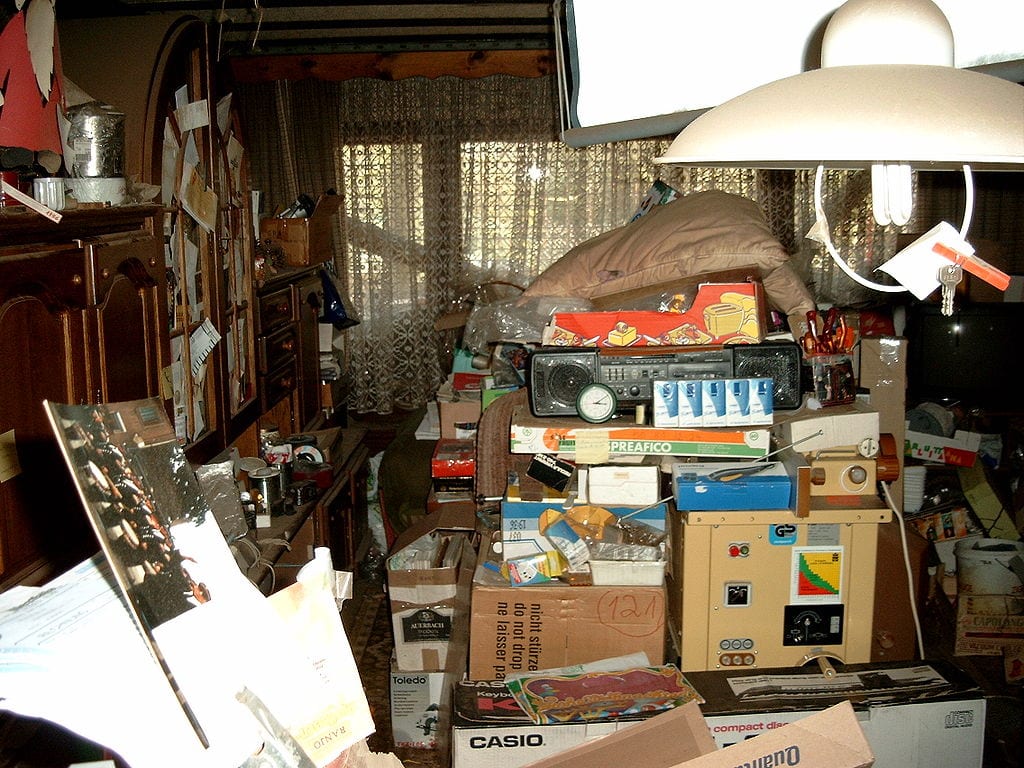After nearly a century of industrial consumerist culture, we have too much stuff. As we start to unpack and purge, let’s find a different way to live.
If you’ve ever criticized the capitalist system out loud, you’ve probably gotten blowback that included praises of how much stuff Capitalism has given us. We have iPhones and refrigerators, for heaven’s sake! How can you question the obvious benefits, people wonder. Considering the current popularity of Marie Kondo and her life-changing tidying, though, one could be forgiven for thinking that, perhaps, just maybe, we have too much stuff.
We live in a culture that’s gone all-in for consumerism. It’s not just iPhones and refrigerators. We also have Unicorn Poop fragrance oil, glittery dog scrotums, and individually plastic-wrapped bananas. A certain amount of material wealth can conceivably improve our day-to-day existence, but we’ve long passed that point and dived straight into the ridiculous. Yet people also depend upon jobs in the cash economy, even if their job is wrapping all of those bananas, in order to feed their families. It’s a no-win situation, since we are burning through our ecosphere turning resources into too much stuff, but stopping the madness means being unable to support our exploding population without changing the system.
It’s not a new problem. People have bemoaned the propensity for hoarding for years. A 2014 LA Times article claims that the average U.S. household contains 300,000 items, and that while only 3.7% of the world’s children are American, those kids controlled 47% of the world’s toys and children’s books. Americans, in particular, were pushed into consumer culture. In the 1920s, American industry was producing pretty much everything people needed and people were starting to reduce their work hours to enjoy more leisure (and help spread the work during the Great Depression), but business leaders saw this as a lost income opportunity. After WWII ramped up the country’s productivity by building vast piles of items designed to explode, all that capacity (and the financial opportunity it represented) would have gone to waste if people didn’t step in to prop it up by buying too much stuff they didn’t really need.

We may be hitting “peak consumer culture,” though. Old habits die hard, as some of Marie Kondo’s early adopters discovered. A writer for The Atlantic checked in on people who had used the KonMari approach to purge their belongings between 2015 and 2017, only to find that many had slowly accumulated too much stuff again.
The good news is that after the peak comes the decline. Resale shops are currently experiencing a rise in donations thanks to the “Marie Kondo” effect, as people tidy their spaces and find too much stuff that doesn’t “spark joy.” Kondo isn’t the only cause of the well-stocked resale shops, though. We’re in a time of generational change. As the Greatest Generation passes away and the Boomers downsize in anticipation of moving into smaller homes or assisted living arrangements, more goods, some of surprisingly high quality, will find their way back onto the market. Buying well-made used goods is kinder to the environment, too, even as it doesn’t support manufacturing jobs.
Will Millennials line up to buy, though? So far, they haven’t appeared to be too interested in snapping up the debris field left behind by the older generations. They may even take the lessons learned from clearing out their parents’ homes and apply it to their own clutter. Broke and indebted, they may be unable to afford the pursuit of too much stuff, or own a big house to store it all in. And they’re more interested in spending what they have on experiences, anyway. They just aren’t interested in the retail therapy and accumulation style of previous generations. Maybe they’ve learned something from watching us after all.
Sadly, this probably means those collections of Beanie Babies aren’t going to be worth much (although that old Lego may be). On the plus side, maybe we can start moving to a more environmentally friendly economy with more leisure time, and not a moment too soon.
Related: Amazon Workers Squeezed to the Limit
Sources:
Glittery Scrotums Are The Latest Dog Grooming Trend And Why Not?
What Do Early KonMari Adopters’ Homes Look Like Now?
The ‘Marie Kondo effect’? Thrift stores nationwide see an uptick in donations
Swedish death cleaning is the morbid new way to de-clutter your life
Retailers Are Suffering Because People Want Less Stuff
New research says secondhand Legos are surprisingly valuable
For many people, gathering possessions is just the stuff of life
The Gospel of Consumption
There’s A Staggering Conspiracy Behind The Rise Of Consumer Culture


Join the conversation!